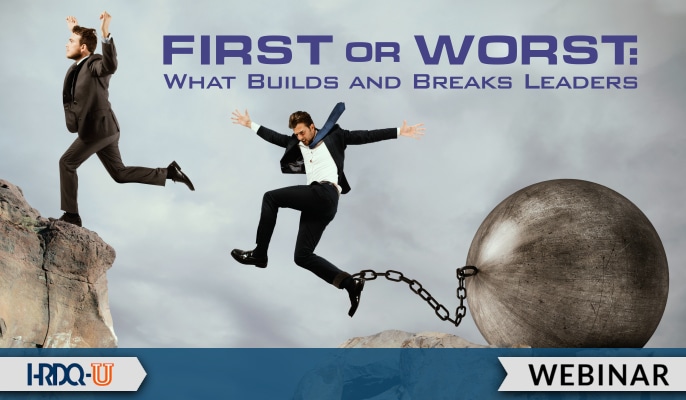Don’t miss this upcoming event from HRDQ-U

You want to be successful as a leader, right? Nobody moves into the leadership ranks set on failing. Yet many do fail, and many more just hang on for dear life! Becoming a leader is one thing; enduring and succeeding in a leadership role is quite another!
Drawing on over 30 years of working with leaders, leadership expert Bill Treasurer will share stories, insights, and practical tips about what causes leaders to flounder and fail and what causes them to succeed and soar.
Through a special partnership between HRDQ and Giant Leap Consulting, webinar attendees will get an exclusive discount on Bill Treasurer’s new Leadership Essentials Academy.
This live event is free. A recording will be available after the event with an HRDQ-U Membership for Learning Professionals.
Get 40% Off!
Giant Leap Consulting and HRDQ-U are pleased to offer a special discount for HRDQ webinar viewers. This steep discount is available exclusively to HRDQ customers because of our long-standing collaboration, and belief in each other’s missions.
Bill Treasurer is the founder of Giant Leap Consulting, Inc., and the author of six books. Bill’s newest book, Leadership Two Words at a Time, serves as a leadership playbook that any leader can use to amp up their effectiveness, performance, and productivity. Bill recently launched the Leadership Essentials Academy, a virtual learning experience that was developed exclusively for new leaders.
For the last three decades, Bill has led courage-building workshops for thousands of leaders throughout the world, including for such renowned organizations as NASA, Accenture, UBS Bank, Spanx, Lenovo, eBay, Walsh Construction, Southern Company, Saks Fifth Avenue, the National Security Agency, and the U.S. Department of Veterans Affairs.
Connect with Bill at BillTreasurer.com.
Giant Leap Consulting, Inc., is on a mission to build workplace courage. We partner with our valued clients to set bold strategies, build strong teams, and develop courageous leaders. Our aim is to drive out fear so that everyone can work with more honesty, accountability, passion, and enjoyment. Repeat clients include NASA, eBay, Lenovo, Southern Company, the National Science Foundation, and the Social Security Administration.
Training Tools for Developing Great People Skills
This event is sponsored by HRDQ. For 45 years HRDQ has provided research-based, off-the-shelf soft-skills training resources for classroom, virtual, and online training. From assessments and workshops to experiential hands-on games, HRDQ helps organizations improve performance, increase job satisfaction, and more.
Learn more at HRDQstore.com

“Bill Treasurer was very knowledgeable about the subject presented. I enjoyed they webinar tremendously and learned something about my leadership style. I can use what I learned both at work and at home. This is one of the best that I have attended.”
Jill B.
Court Reporting Specialist
Collier Clerk of the Circuit Court

“The information that Bill shared in his webinar gave me pause to assess how I am showing up as a leader. Thank you for this informative session.”
Barbara S.
Program Management Specialist
University of Maryland Baltimore County

“The webinar was thoughtful, insightful, and carefully organized to present concepts in a way that made them broadly applicable but with room to be tailored as needed. This included the instructor engaging the audience through polls and answering individual questions through Q&A, which was very helpful.”
Emma G.
Student
University of Maryland Baltimore County

Sign up for more as a member of HRDQ-U
HRDQ-U offers much of its learning content free to visitors, including live and select webinars, blog posts, and more, with new events and posts shared every week. However, there is much more learning available. You can access our complete library of on-demand webinars and other training events and content by simply signing up.
5 Responses
Question: What’s the best way to clear up misunderstandings between management staff use face-to-face or e-mails?
Answer: I find that misunderstandings are better handled, and I would say, voice to voice is what I would say. Hey, if it can be face-to-face, proximity with one another together, that is the ideal, right? Because that, ’cause then you’re getting the facial cues. You’re getting the body language there, The kinship is very high. That said, what what? I realize the remote realities of today’s hybrid workforce. What I would say is to have that misunderstanding cleared up. If, if it’s one-on-one if it’s the misunderstandings between you and another person or you and two people have it with that. If it’s with the team, then the team has to have A Heart to heart kind of conversation. It’s, it is challenging, even if you have to do it through zoom or go to meetings or whatever platform you might use, you do you I think e-mail would be a poor way to have it because it’s, um, you know, the language is easily misconstrued. The intonation is gone outside of e-mail. I will say that everything that I’m saying has to have a little shade of gray in here. The gray area is sometimes writing something, can force you to be exact and thoughtful. I’ve written notes of apology that were letters that, but they were hand-written and it shows that I took the kind the time to do it. So I’m not, I’m not, I don’t want to be like always or never. I do think there is a place for thoughtfully constructed apology or or clearing up your side of a Misunderstanding. but what the caution would be, is, in the Misunderstanding, don’t don’t take on the burden of pointing out what they did wrong in the Misunderstanding, right. So, it’s, that’s another reason why it works a lot better if it’s not one-way communication where you’re just typing something to them. But occasionally, I imagine that there probably would be something that would work.
Question: Is it possible to repair relationships?
Answer: If you are a poor leader, That’s a thoughtful question. I appreciate it. But my short answer is yes. I think it’s possible not only that, I think that if you are sincere and you know, the if you sort of apologized deeply and sincerely, and say, say the words not just I apologize which sounds so formal. But to say, I’m sorry. Say those words. And then go further and say, I hope that you can come to forgive me, ask for forgiveness, and then you’ve got to back it up and make them whole for wherever you were deficient. So for whatever, maybe maybe you violated a confidence. Maybe you did it innocently, but maybe that was it Or maybe you had some unsafe behavior in the past that made them feel threatened or or afraid. I don’t know what it would be, right, but it could be anything. But if you make the apology, ask for forgiveness, say you’re sorry, do right by them. In fact, you can make the relationship better than women that greet that when that happened in the first place. It’s a lot like service recovery in customer service. Remember, Ken Blanchard said I work for you. You don’t work for me. That means that you as a leader, have sort of a customer service, responsibility to your team. And just as when a company sometimes get something wrong, and then they give you the money back guarantee, or they give you an extra item for free, because they are trying to make it whole, then you come to forgive that company and you respect that company more. The leader can actually earn the respect when they admit their mistake, they apologize for their mistake, and they make it better.
Question: How do you get the leadership to stop taking credit for the work of their team?
Answer: It’s a sign of a mature leadership. And I’ve been the recipient of that. I can think of a very specific instance. If somebody who I greatly admire and appreciate it is super, super talented but has a habit of not giving like in rooms full of people will not share the credit for something that many others have contributed to. Um, and I do think that it does kind of go back to, you know, maybe it’s introducing that concept of psychological safety with the team, and having a team talk about what would psychological safety look like here on our team, and having that discussion. And, and part of it is what gets in the way, what, what would being, what does unsafe look like for us? And then this item could come out, you know, when people take credit for their work, And then we can write ourselves around. How do we think we do around these barometers of creating safe or unsafe environments? Or where might we need to do better? And then to the extent that you could actually create enough safety where somebody could give that feedback to that leader in a kind way and helpful way, you know, firm affair, that would be helpful. But I, I make no claims on it being an easy discussion to have.
Question: How do you get people to be more engaged in the team as a leader?
Answer: That’s a challenging situation.There was there will be some people when they move into a leadership role that will enjoy the privilege that leadership is as and they will, they will think of it as the privileges that come with leadership and they start to take advantage of those privileges as sometimes they might become distant from the work. And they’ll have all sorts of excuses for it, that they’ve gotta go to that more important meeting than could be with the team. You know, some of them liked to play golf, right? So you do get some leaders who become a little bit removed once they move into a leadership role. I think it’s a rare event, but it does happen. I think that, you know, I go back to what I said before. When you’re envisioning, what would the team look like? I think it’s important too, for roles to be clarified with one another. And when you’re working with a team, two, you can literally go around to each team member and say, have that person. Stand on the flipchart and say, what do we perceive this person’s role to be? And the person up at the flipchart has to be quiet. They just take down through dictation, what they hear the group say, whether or not it is in fact, accurate. So, the question is they say, What do we perceive this person’s role to be? Then, then that person lists those items, and then that person on a separate piece of flipchart paper and through discussion says, this, is what my role actually is responsible for. Except, we also do it for the leader. So, we’re able to say, we think that, your role is to be responsive to our needs. We think that your role is to go to bat for us. We think your role is to provide air cover, we think your role is and the leader will get that feedback real-time. That’s one thing I would say. The other thing is, if your organization has a 360 degree feedback process, it could be good to invite the opportunity for that leader and others, maybe even yourself to go through that process because you want to validate that it’s not just you that are noticing that and have unassailable data and a 360 is very helpful. Be able to provide that. What won’t work as Shida is you, you know, sort of going up with your hands on your hips and looking them with a stern. Look in the face saying you’re not engaged enough around here. Like, that won’t work, right? Like, when we, when we think that we can just sort of point out a person’s flaw and get them change. Now, if you have a good high trust relationship with that person, and they appreciate your honesty, and they’ve invited your honesty, then it’s a different equation. Then that, and, there’s enough psychological safety between the two of you: You could give direct feedback and say, I’ve noticed that you’re not as engaged as I’ve seen you in the past, and, I’m just wondering if, you know what? What might be going on? And, is there anything I might be able to do to help? So, that would be another approach.
Question: What do I feel are the foundations to a healthy and high functioning team?
Answer: When you’re in a leadership role, you are oftentimes and in particular, John, we moved from that individual contributor role. The very first people we’re leading often are a small team. Sometimes maybe we might get one or only two people, but oftentimes we’re handed a team. Then, as you progress, you just become responsible for more and more teams or bigger teams. So understanding the foundations of teamwork are really important. I think that what is important on a team is to end, and, John, just so that you know, I did, I have facilitated some 500 team building events over time before I started in my own company and before I worked at Accenture, where I did for a number of years in management, I was with a company called executive adventure. And we did outdoor experiential team building, and I facilitated teams of people going through team building experiences with one another. And what I’ve found is that it’s really helpful for teams, Particularly when a team is launching, if you have the luxury of being part of a team as it’s kicking off, is to identify a shared number of protocols. You and I can call them ground rules, but most people don’t like to work under rules. So we call them protocols. So, set protocols with the team, things that will be OK and not OK on your team. In fact, that’s often how we do it with two flip charts. We have the OK list and the not OK list. And things like, it’s not OK to not respond to an e-mail within 24 hours on that particular team. It’s not OK to to use disrespectful language. It’s not OK to be late, 15 minutes late for a meeting, without telling us why you were late for the meeting. Who knows what the list will say, but each team should come up with their OK, and not OK list? That’s helpful For the team, when they’re launching a project to envision project Success. If we were being if we were delivering the Best work that we could deliver as a team, what would the work look like, right, so what does the output of the work look like, and what would we look like if we were a team that would be able to point back to this experience and say, I’m proud that I was a member of that team. What would we look like in terms of how we operate? How we communicate with one another? How we handle mistakes with one another. So those are some things, setting some ground rules or protocols. And, and figuring out what does success look like and what do we look like when we’re being successful as a successful team.